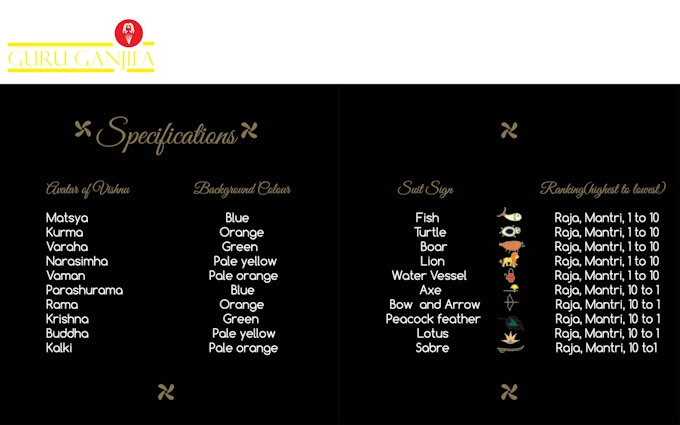India
Posted: Mon Feb 03, 2014 1:17 am
Ganjifa
This deck of 96 circular cards reproduces a Mogul Ganjifa deck from Rajasthan, India of around 1785. The original is in the collection of the Fournier Museum in Vitoria, Spain and they produced this reproduction in 2004. The cards are the same size as the originals at 6.3 cm across. The originals were stiff lacquered cards that came in a decorated wooden box. This copy comes in a rather plain black cardboard box with a picture of one of the pip cards on the front.
Ganjifa are usually round and come in large decks of 8 or more suits, 12 cards to each suit. There are 2 court cards in each suit, a king (or lord, or rajah, etc.) and a general (second in rank), and pip cards from 1 - 10. The cards range in size from 2 - 12 cm in diameter. They have many different themes leading to varied styles and suits. Even between decks of similar type considerable differences exist, according to the area they come from, and who painted them. Traditional Ganjifa cards were, and are, handmade and hand painted, each single card being a work of art. The common materials used are wood, stiffened cloth, and paper, but higher priced Ganjifa decks were often painted on a precious substance like tortoise shell, ivory, or mother of pearl.
Used to play a game called Ganjifa, the cards may be based on the now extinct Persian cards for the anciant game of As-Nas (which has some similarity to Poker), though there is some evidence the card form dates from before the Moguls conquered India in 1526. The name Ganjifa does come from the Persian word ganjifeh (گنجفه), which is what playing cards are called in India, Nepal, Iran, some Arab countries, and Turkey. Ganjifeh actually translates as Treasure Cards, and the presence of a money suit in every deck may suggest a link to the earlier money suited cards of China.
The 8 suits of this deck are Servants, Gold Coins, 2 different Flowers, Harps, Sabres, and two suits I'm not sure of - one of which may be a Bill of Exchange and the other might be Wrapped Merchandise. Each suit has it's own background colour, and the card backs are red with 2 parallel gold lines running close to the card edge.
These cards are in the Fournier Catalogue: volume 1, page 327, #16 of India[/color]
This deck of 96 circular cards reproduces a Mogul Ganjifa deck from Rajasthan, India of around 1785. The original is in the collection of the Fournier Museum in Vitoria, Spain and they produced this reproduction in 2004. The cards are the same size as the originals at 6.3 cm across. The originals were stiff lacquered cards that came in a decorated wooden box. This copy comes in a rather plain black cardboard box with a picture of one of the pip cards on the front.
Ganjifa are usually round and come in large decks of 8 or more suits, 12 cards to each suit. There are 2 court cards in each suit, a king (or lord, or rajah, etc.) and a general (second in rank), and pip cards from 1 - 10. The cards range in size from 2 - 12 cm in diameter. They have many different themes leading to varied styles and suits. Even between decks of similar type considerable differences exist, according to the area they come from, and who painted them. Traditional Ganjifa cards were, and are, handmade and hand painted, each single card being a work of art. The common materials used are wood, stiffened cloth, and paper, but higher priced Ganjifa decks were often painted on a precious substance like tortoise shell, ivory, or mother of pearl.
Used to play a game called Ganjifa, the cards may be based on the now extinct Persian cards for the anciant game of As-Nas (which has some similarity to Poker), though there is some evidence the card form dates from before the Moguls conquered India in 1526. The name Ganjifa does come from the Persian word ganjifeh (گنجفه), which is what playing cards are called in India, Nepal, Iran, some Arab countries, and Turkey. Ganjifeh actually translates as Treasure Cards, and the presence of a money suit in every deck may suggest a link to the earlier money suited cards of China.
The 8 suits of this deck are Servants, Gold Coins, 2 different Flowers, Harps, Sabres, and two suits I'm not sure of - one of which may be a Bill of Exchange and the other might be Wrapped Merchandise. Each suit has it's own background colour, and the card backs are red with 2 parallel gold lines running close to the card edge.
These cards are in the Fournier Catalogue: volume 1, page 327, #16 of India[/color]


